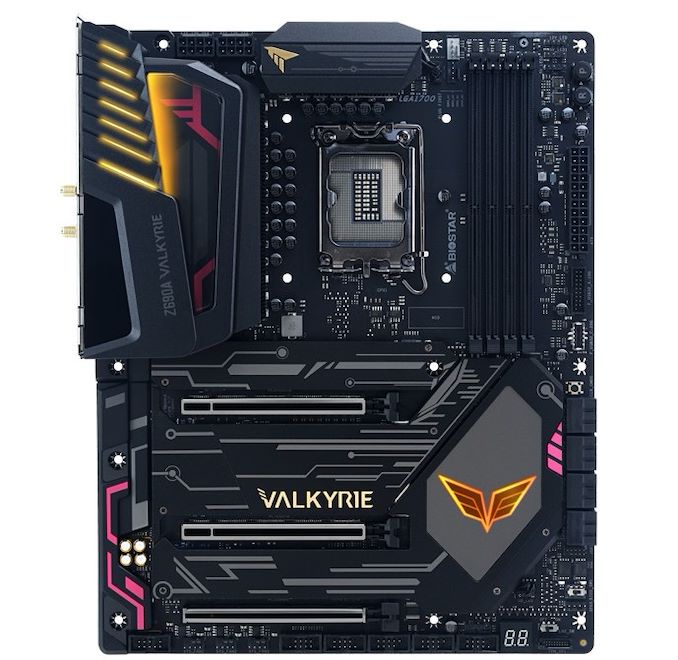The Intel Z690 Motherboard Overview (DDR4): Over 30+ New Models
by Gavin Bonshor on November 24, 2021 2:00 PM ESTBiostar Z690A Valkyrie (DDR4)
Despite not having a large stack at the moment, Biostar has launched three Z690 models for Intel's Alder Lake desktop platform. Representing one of two premium Z690 models at launch is the Biostar Z690A Valkyrie, which shares the same PCB and primary specifications as the non-A variant. The Biostar Z690A Valkyrie has an 'anime' look of sorts, with a primarily black theme and colorful elements with RGB enabled backlighting in the rear panel cover and chipset heatsink. The Z690A Valkyrie combines a decent controller set, along with all the typical Z690 and 12th gen features such as PCIe 5.0, and opts for DDR4 memory support over the DDR5 supported non-A Valkyrie model.
The Biostar Z690 Valkyrie has plenty of PCIe slot expansion slot real estate, including two full-length PCIe 5.0 slots that can operate at x16 and x8/x8, with a third full-length PCIe 4.0 x4 slot. Storage options include a total of four PCIe M.2 slots, including three PCIe 4.0 x4 M.2 slots, one PCIe 3.0 x4 M.2 slot, and eight SATA ports. Biostar also includes four memory slots which can be found in the top right-hand corner, with support for DDR4-5000 and a maximum capacity of up to 128 GB.
On the rear panel is a high-speed USB 3.2 G2x2 Type-C port and a total of seven USB 3.2 G2 Type-A, with plenty of options for integrated graphics. For those users, Biostar includes two DisplayPort 1.4 and two HDMI 2.0 video outputs which shows lots of potential integrated GPU support. On the networking front, there's one Intel I225-V 2.5 GbE port, and although it has the connectors for a Wi-Fi 6E CNVi, Biostar isn't clear on whether the Z690A Valkyrie actually includes the CNVi; the rear panel says yes, but the specifications say no Wi-Fi 6E card is included. Finishing off the rear panel are five 3.5 mm audio jacks and S/PDIF optical output powered by a Realtek ALC1220 HD audio codec, as well as a PS/2 combo port.












42 Comments
View All Comments
meacupla - Wednesday, November 24, 2021 - link
Those boards are probably still stuck in the Pacific.Mat-mat - Thursday, November 25, 2021 - link
Why not include the Z690 TORPEDO, Z690 ACE, Z690 FORCE, Z690 Taichi, Z690 AORUS XTREME and Z690M DS3H DDR4 (not yet released).By the way, love the fact that the Phantom Gaming 4 boards look no-nonsense in style, while it has DrMOS MOSFETs for VRM power delivery.
PlasticMouse - Thursday, November 25, 2021 - link
Small typo: Previously with 11th gen (Rocket Lake), Intel upheaved it from a PCIe 3.0 x4 uplink on Z490 to a PCIe 3.0 x4 (x8?) uplink on Z590. With Z690, the uplink is now fully-fledged PCIe 4.0 x8 lanes to interconnect things.GarBaGe - Thursday, November 25, 2021 - link
"Intel upheaved it from a PCIe 3.0 x4 uplink on Z490 to a PCIe 3.0 x4 uplink on Z590. With Z690, the uplink is now fully-fledged PCIe 4.0 x8 lanes to interconnect things."This is wrong. Probably just a typo, since the author uses a phrasing which suggests it is a typo.
Z490 has 4 links PCIe 3 from CPU to chipset.
Z590 has 8 links (not 4) PCIe 3 from CPU to chipset
Z690 has 8 links PCIe 4 from CPU to chipset.
My question to Intel: If Z690 is supposed to be your first PCIe 5 platform, why not use PCIe 5 from CPU to chipset instead of PCIe 4?
DazFG - Thursday, November 25, 2021 - link
what listing motherboards with diagnostic panels for overclockers, or how many power phases.cgull.at - Thursday, November 25, 2021 - link
This has been irritating me a bit for a while: "Over 30+ new models"That's redundant. It's like saying "More than more than 30 new models". Pick one or the other. Please?
T2daroy - Thursday, November 25, 2021 - link
I'm considering the MSI MPG Z690 Edge WIFI DDR4. What are your thoughts on this?quantumshadow44 - Thursday, November 25, 2021 - link
}}}While Intel states that it includes an integrated 2.5 GbE MAC/PHY, this is a little nonsensical, as wired ethernet still requires a MAC/PHY as an attached PCIe controller. This means regardless of whether a vendor is using a Gigabit, 2.5 GbE, or even 10 GbE, it connects the exact same way to the PCIe interface.Can someone explain to me why is it "nonsensical"? Thanks.
GreenReaper - Saturday, November 27, 2021 - link
I think the assertion is that the chipset doesn't contain anything to enable this. It's like "you could buy [a motherboard with] a PCIe-based 2.5Gbps Ethernet solution, and it could be from Intel, so we'll list it as a feature".Conversely, for 1Gbps, the Z690 spec sheet lists: "Intel® Integrated 10/100/1000 MAC: Support for the Intel® Ethernet Connection I219-V" - https://ark.intel.com/content/www/us/en/ark/produc...
If you read the datasheet for that it suggests that the I219-V basically turns one of the PCIe links to the PCH ("chipset") into a half-speed Gen1 2.5Gbps connection - but it's not actually the PCIe protocol, it sends Ethernet packets from the I219-V PHY to be handled by the PCH. It also works in SMBus mode at 10Mbps to provide functionality when the machine is a lower-power state.
There is a lot of wake-up functionality which means it has to be able to detect bit patterns, direct-addressed IPv4/6 wakeups, etc, but it relies on chipset features to otherwise process packets.
ScottSoapbox - Saturday, November 27, 2021 - link
"Intel upheaved it from a PCIe 3.0 x4 uplink on Z490 to a PCIe 3.0 x4 uplink on Z590."